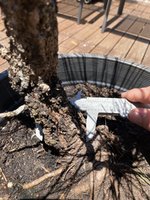Hey All,
Was hoping for some advice on the roots in the attached photos.
In my naivety, i didn’t really have any concern about the artistically coloured ( ) roots in these photos.
) roots in these photos.
They didn’t concern me hugely in an aesthetic way - meh, certainly not ideal, but you’ve got to start somewhere - and i’d thought they might fuse with time anyway.
Since my blissful unawareness, i’ve been aware’d that ‘strangler roots’ are indeed a thing, and as the name suggests, can potentially kill certain areas of a trunk.
So i was after some advice as to what my options are.
Being a pine, and being that pines move fluid and nutrients (i believe) horizontally as well as vertically, killing segments if the trunk wouldn’t necessarily kill off branching above??? But regardless, that seems like it might be a silly and lazy route to take.
So is it best, in regards to tree health and development if all - or some - of these roots come off?
If there aren’t health issues to leaving them - which it seems is unlikely - will they potentially fuse and become less unsightly with time?
Is there anything else i’m missing or should be considering?
I presume if they are to be removed, it’d be best to do so one at a time, or through periodic pruning and reduction of dependance?
Thanks in advance!


Was hoping for some advice on the roots in the attached photos.
In my naivety, i didn’t really have any concern about the artistically coloured (
They didn’t concern me hugely in an aesthetic way - meh, certainly not ideal, but you’ve got to start somewhere - and i’d thought they might fuse with time anyway.
Since my blissful unawareness, i’ve been aware’d that ‘strangler roots’ are indeed a thing, and as the name suggests, can potentially kill certain areas of a trunk.
So i was after some advice as to what my options are.
Being a pine, and being that pines move fluid and nutrients (i believe) horizontally as well as vertically, killing segments if the trunk wouldn’t necessarily kill off branching above??? But regardless, that seems like it might be a silly and lazy route to take.
So is it best, in regards to tree health and development if all - or some - of these roots come off?
If there aren’t health issues to leaving them - which it seems is unlikely - will they potentially fuse and become less unsightly with time?
Is there anything else i’m missing or should be considering?
I presume if they are to be removed, it’d be best to do so one at a time, or through periodic pruning and reduction of dependance?
Thanks in advance!






